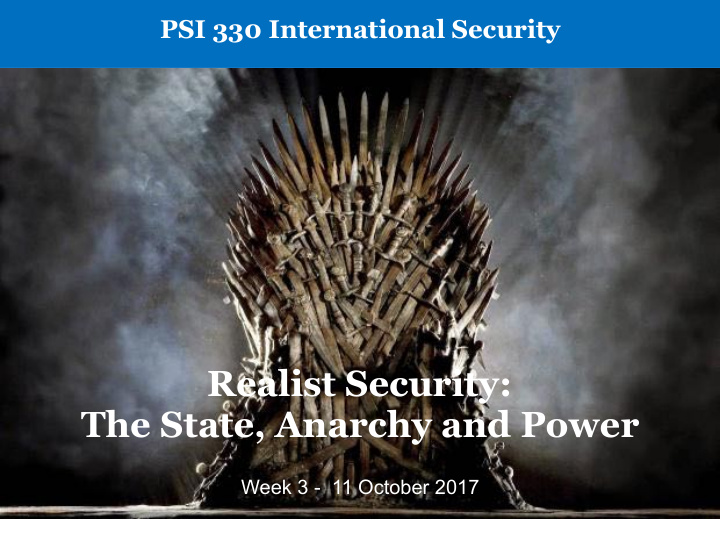



PSI 330 International Security Realist Security: The State, Anarchy and Power Week 3 - 11 October 2017
Realist House Classical Realism Neorealism Defensive Realism Offensive Realism Rise and Fall Realism Neoclassical Realism
Common Features • Focus on three factors: Power, Fear and Anarchy • Seek to explain conflict and war. • Pessimistic view of the social world. • Search for power mainly determines the state behavior • Main Questions: • What is Security? • Whose Security? • What are the Primary Threats? • How can Security be Achieved?
Classical Realism • Search for more power is due to flaws in human nature • Anarchic international system permits search for more power • Characteristics of rulers or the nature of domestic politics causes war • States are rational actors (cost & benefit analysis)
Neorealism • Defining a political structure • An Ordering Principle: Anarchic or Hierarchical • The Character of Units: functionally alike or differentiated • The Distribution of Power • International Structure • First two elements are constant • Variety in capabilities • Differences in capabilities and distribution of power determines the nature of the international structure: bipolar or multipolar
Neorealism • Determinants of State Behavior • The only factor is that states seek survival • Indifference to rationality • Several factors can explain state behavior • Competition among states • Product of socialization, states can follow the norms • Stability and interdependence in the International System • Bipolar: high stability, low interdependence • Multipolar: low stability, high interdependence • Unipolar: nearly impossible
Defensive Structural Realism • Assumption of Rational Choice • Offense-Defense Balance • Defense often wins, because of the improvements in weapons technology and/or geography. • Balance of Threat (variant) • States Should Support Status Quo • Why does War Occur? • Domestic-level factors • Extreme Security Dilemma makes states revisionist
Security Dilemma Other states take action to protect the status quo State A increases State A is threatened military capabilities by others’ actions, increases its military capabilities furthermore. Other states respond in kind.
Security Dilemma • Various Definitions: • “by initially trying to enhance its own security, State A sets in motion a process that results ironically in its feelings less secure” (Viotti and Kauppi 1987, 603) • “what one does to enhance one’s own security causes relations that, in the end, can make one less secure” (Posen 1993, 28) • “The core argument of the security dilemma is that, in the absence of a supranational authority that can enforce binding agreements, many steps pursued by states to bolster their security have the effect - often unintended and unforeseen - of making other states less secure” (Jervis 2001, 36)
Security Dilemma • Booth & Wheeler (2008, 4-5) definition: The Dilemma of Interpretation The Dilemma of Response Defensive or self- Signal protection Reassurance State A increases military capabilities Offensive React in kind State B
Offensive Structural Realism • States should acquire as much power as they could • Uncertain international environment • Offensive capabilities can hurt • Countervailing response is not necessarily triggered • Most powerful state (the ultimate safety) • Regional hegemon (the second best option) • If everything else fails, at least try to become wealthy and have military capabilities for the land warfare.
Offensive Structural Realism • Various tools for Gaining Resources • States resort war • Blackmail • Baiting states into making war on each other while standing aside • Engaging competitors in long and costly conflicts • Forestall Others From Gaining More Power • Using third party to cope with the threat (buck-pass) • Balance the threat by themselves • Geography Matters • Likelihood of Great Power War Bipolar Multipolar
Rise and Fall Realism • Leading Power Shapes the International System • Determines the rules and practices • Acts rationally to prevent contenders • If fails, challenger could opt for war • Rise and Fall have never changed • Changes in power always leads to conflict • Power Transition Theory • Three stages of power • Potential Power • Transitional Growth • Power Maturity
Neoclassical Realism • Balance of Interest Theory (Schweller 1994, 100)
Neoclassical Realism • Underbalancing (Schweller 2004) For incoherent states
US Grand Strategy Pull Back or Lean Forward
Recommend
More recommend